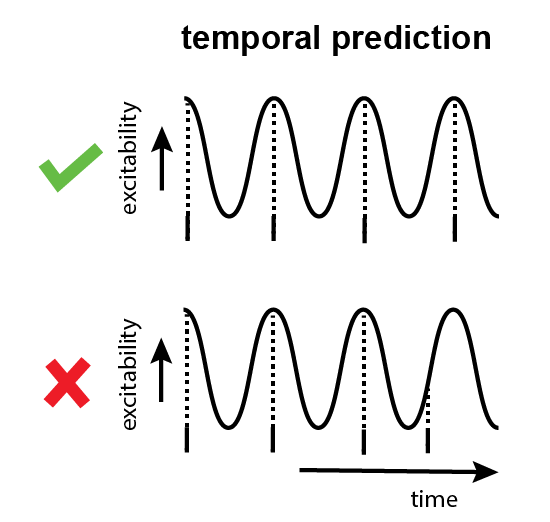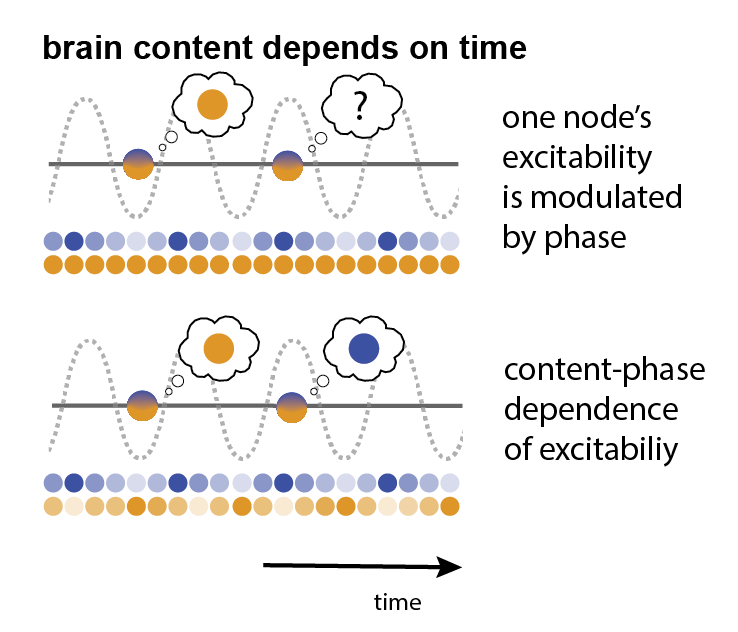Temporal tracking versus temporal coding

Oscillations are time-varying dynamic in the brain which can easily be observed by EEG. An oscillation reflect modulations of excitability shifting from high to low excitability. This excitability change allows for the tracking of temporally structured patterns in the environment, such as music or speech, by aligning input to high excitable phases of an oscillation.
Besides tracking, oscillations also to provide a temporal organizational principle in the brain to structure neural firing. Depending on the excitability of individual neuronal populations, neurons will be active at different moments of an ongoing oscillations. It is likely that there would be a complete chaos of neural firing when oscillations are absent.

These two functions of oscillations - temporal tracking and temporal coding - do not always live in harmony with each other. For example how does the brain use oscillations to structure input arriving at the same moment? Or does the time at which information arrives on an oscillations influence which neuronal population is activated? In this research line we investigate both functions as well as the interaction of these functions.
Relevant publications
- Ten Oever, S. & Martin, A.E. (2023). Interdependence of what and when in the brain. Journal of Cognitive Neuroscience.
- Ten Oever, S., van der Werf, O.J., Schuhmann, T., & Sack, A.T. (2022). Absence of behavioural rhythms: Noise or unexplained neuronal mechanisms?(response to Fiebelkorn, 2021). European Journal of Neuroscience.
- Schilberg, L., Ten Oever, S., Schuhmann, T., & Sack, A.T. (2021). Phase and power modulations on the amplitude of TMS-induced motor evoked potentials. PloS one.
- Ten Oever, S., Meierdierks, T., Duecker, F., De Graaf, T.A., & Sack, A.T. (2020). Phase-coded oscillatory ordering promotes the separation of closely matched representations to optimize perceptual discrimination. Iscience.
- Ten Oever, S., De Weerd, P., & Sack, A.T. (2020). Phase-dependent amplification of working memory content and performance. Nature communications.
- De Graaf, T.A., Thomson, A., Janssens, S.E., Van Bree, S., Ten Oever, S., & Sack, A.T. (2020). Does alpha phase modulate visual target detection? Three experiments with tACS‐phase‐based stimulus presentation. European Journal of Neuroscience.
- Ten Oever, S. & Sack, A.T. (2019). Interactions between rhythmic and feature predictions to create parallel time-content associations. Frontiers in Neuroscience.
- Ten Oever, S., Schroeder, C.E., Poeppel, D., Van Atteveldt, N., Mehta, A.D., Mégevand, P., Groppe, D.M., & Zion-Golumbic, E. (2017). Low-frequency cortical oscillations entrain to subthreshold rhythmic auditory stimuli. Journal of Neuroscience.
- Ten Oever, S. & Sack, A.T. (2015). Oscillatory phase shapes syllable perception. Proceedings of the National Academy of Sciences.
- Ten Oever, S., Van Atteveldt, N., & Sack, A.T. (2015). Increased stimulus expectancy triggers low-frequency phase reset during restricted vigilance. Journal of cognitive neuroscience.